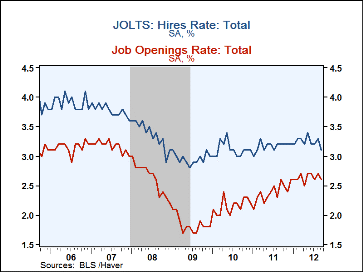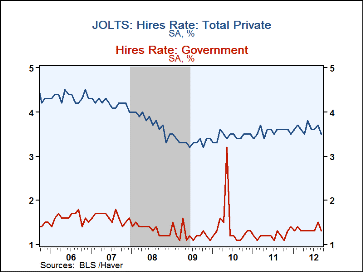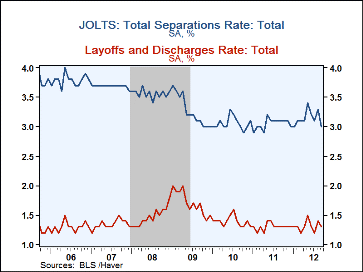 Global| Nov 08 2012
Global| Nov 08 2012U.S. JOLTS: Job Openings Rate Slips
by:Tom Moeller
|in:Economy in Brief
Summary
The Bureau of Labor Statistics reported Tuesday in its Job Openings & Labor Turnover Survey (JOLTS) that the September job openings rate slipped to 2.6% from a revised 2.7%. It still was improved versus the recession low of 1.6%. The [...]
 The Bureau of Labor Statistics reported Tuesday in its Job Openings
& Labor Turnover Survey (JOLTS) that the September job openings
rate slipped to 2.6% from a revised 2.7%. It still was improved versus the
recession low of 1.6%. The job openings rate is the number of job
openings on the last business day of the month as a percent of total
employment plus job openings. The actual number of job openings fell
2.7% to 3,561 (+1.7% y/y).
The Bureau of Labor Statistics reported Tuesday in its Job Openings
& Labor Turnover Survey (JOLTS) that the September job openings
rate slipped to 2.6% from a revised 2.7%. It still was improved versus the
recession low of 1.6%. The job openings rate is the number of job
openings on the last business day of the month as a percent of total
employment plus job openings. The actual number of job openings fell
2.7% to 3,561 (+1.7% y/y).
The private-sector job openings rate held for the third consecutive month at 2.8%, up versus the recession low of 1.7%. The job openings rate in professional & business services fell to 3.5% versus its December high of 4.3%. In leisure & hospitality, the rate fell to 2.8%, a one year low. The rate in education & health services recovered to 3.3%. In manufacturing the rate again fell to 2.0%, off sharply from the March high of 2.5%. The job openings rate in government retreated to 1.6% from the recent high of 1.8%.
Reversing an earlier sign of improvement, the hires rate fell to 3.1%, the lowest level since July of last year but still up from the recession low of 2.8%. The hires rate is the number of hires during the month divided by employment. The hires rate in the private sector fell sharply m/m to 3.5% and the government's rate fell back to 1.3%. In leisure & hospitality, the hiring rate continued quite firm at 5.1% but the factory sector hires rate held at an economic recovery low of 1.9%. In education & health services, the rate fell to a still relatively high 2.4%. Overall hires in the private sector fell a sharp 4.9% (-2.3% y/y). Professional & business services hires fell 5.7% (-5.3% y/y) while leisure & hospitality hires dropped 7.0% (-5.6% y/y).
The job separations rate dropped to 3.0%, a nine month low. The actual number of separations declined 7.6% (-1.6% y/y. Separations include quits, layoffs, discharges, and other separations as well as retirements. The layoff & discharge rate alone slipped to 1.3%, about what it's averaged for over a year. The private sector layoff rate was 1.4% while in government it was a lower 0.4%.
The JOLTS survey dates only to December 2000 and the figures are available in Haver's USECON database.
| JOLTS (Job Openings & Labor Turnover Survey) | Sep | Aug | Jul | Sep'11 | 2011 | 2010 | 2009 |
|---|---|---|---|---|---|---|---|
| Job Openings, Total | |||||||
| Rate (%) | 2.6 | 2.7 | 2.6 | 2.6 | 2.6 | 2.2 | 1.8 |
| Total (000s) | 3,561 | 3,661 | 3,593 | 3,501 | 3,540 | 2,902 | 2,432 |
| Hires, Total | |||||||
| Rate (%) | 3.1 | 3.3 | 3.2 | 3.2 | 38.0 | 37.4 | 35.5 |
| Total(000s) | 4,185 | 4,440 | 4,278 | 4,276 | 50,006 | 48,647 | 46,386 |
| Layoffs & Discharges, Total | |||||||
| Rate (%) | 1.3 | 1.4 | 1.2 | 1.3 | 15.6 | 16.7 | 20.5 |
| Total (000s) | 1,701 | 1,848 | 1,582 | 1,765 | 20,678 | 21,737 | 26,731 |
Tom Moeller
AuthorMore in Author Profile »Prior to joining Haver Analytics in 2000, Mr. Moeller worked as the Economist at Chancellor Capital Management from 1985 to 1999. There, he developed comprehensive economic forecasts and interpreted economic data for equity and fixed income portfolio managers. Also at Chancellor, Mr. Moeller worked as an equity analyst and was responsible for researching and rating companies in the economically sensitive automobile and housing industries for investment in Chancellor’s equity portfolio. Prior to joining Chancellor, Mr. Moeller was an Economist at Citibank from 1979 to 1984. He also analyzed pricing behavior in the metals industry for the Council on Wage and Price Stability in Washington, D.C. In 1999, Mr. Moeller received the award for most accurate forecast from the Forecasters' Club of New York. From 1990 to 1992 he was President of the New York Association for Business Economists. Mr. Moeller earned an M.B.A. in Finance from Fordham University, where he graduated in 1987. He holds a Bachelor of Arts in Economics from George Washington University.








